|
|
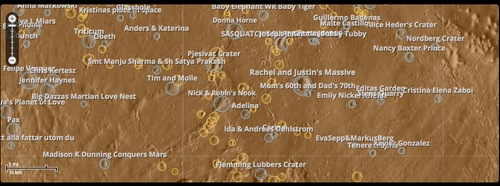 A screenshot of Uwingu’s Mars map, populated with a variety of names of craters purchased by the public. Last week, Uwingu, a venture that last year solicited names for exoplanets, announced that it was allowing the public to name craters on Mars. Starting at just $5 (and up, depending on the size of the crater), people could pick a crater that currently has no name on Mars and name it. Uwingu plans to use those funds to support space research and education: in excess of $10 million dollars, if Uwingu gets people to pay for names for all the approximately 500,000 unnamed craters on Mars.
“We’ve had thousands of features named on Mars already,” Uwingu’s Alan Stern said in a phone interview over the weekend. “Since we’ve debuted this, we’ve named about as many features as the old system, naming through the astronomical committees, named in the previous fifteen years.”
The Uwingu website doesn’t keep a running tally of the number of names assigned to date, but does have a map that is updated in near real time that lists the craters that have been named. There’s a mix of craters named after people and those with more… whimsical names: “Daniel’s Pit of Awesome,” “Big Dazzas Martian Love Nest,” and “SASQUATCH’S SLIPPERY SINKHOLE.”
Stern said they plan to examine the choice of names people assign to craters, to look for trends. “Are people naming them after relatives primarily, famous people, historic places on Earth, sports teams, artists; what’s the distribution of naming types?” he said. “We’re interested not just in what people name things, but why they name things.”
Uwingu’s plans to name craters, though, has encountered some opposition. The International Astronomical Union (IAU), which currently handles the naming of features on Mars and other celestial bodies, told Space News last week it would not sanction any of the names chosen by participants in Uwingu’s effort. And, in a blog post yesterday, lunar scientist Paul Spudis expressed his opposition to this effort in no uncertain terms. “I find this new Uwingu scheme offensive because it preys on the ignorance and trust of the general public,” he wrote, likening Uwingu’s Mars map to the International Star Registry, a company that has sold names of stars to the public with the veneer of officialdom, even though those names are not recognized by IAU or other astronomers.
Stern, in the interview, said some people have misunderstood what Uwingu is doing. “We’re not selling anything like property rights or naming rights,” he said. “We’ve just created a Mars map that grandfathers in everything that’s already been named—about 15,000 features—and takes just the craters and asks the public, ‘What would you name these features?'”
Uwingu addresses that issue as well in a FAQ on its website. “How will our Uwingu Mars feature names be used? They’ll be used by anyone using Uwingu’s Mars maps. For now that’s just the public, but soon, we hope, scientists and space missions to Mars will be using these maps too.” In other words, that name is only as official as that map.
On Monday, one organization announced that it would use that map in its future missions. Mars One, the Dutch venture that has long-term plans to send humans to Mars on one-way missions, said its future missions, starting with a lander and orbiter slated for launch in 2018, will carry the Uwingu map, and that it will use the map as part of its mission operations. In return, Mars One will get a share of the proceeds of the Uwingu Fund; Stern said he couldn’t discuss specific numbers, but that Mars One gets a “slice of the Uwingu Fund for a limited period of time” that “leaves plenty of headroom for tons of other grants.”
“For us it’s a really nice partnership,” Mars One CEO Bas Lansdorp said in an interview Sunday on The Space Show, where the agreement between Mars One and Uwingu was first publicly announced. Including the map on Mars One’s 2018 missions is “the really nice thing Mars One can contribute to this partnership,” he added. “That name will actually travel to Mars, land on Mars on 2019… and your name will really be on Mars.”
Of course, Mars One has plenty of skeptics who wonder if the venture can raise enough money to pay for those initial robotic missions, let alone those long-term human plans. Uwingu’s Stern, though, is happy about it. “I’m really psyched about it,” he said of the partnership with Mars One, “because not only can people who put names on our map know that that’s going to the surface of Mars, but also, having an actual an actual Mars mission adopt our map as their standard for mission operations makes it a lot more interesting for people.”
 You didn’t think we would run an article about Kate Upton’s zero-g flight without including a photo of it, did you? (credit: Sports Illustrated) Did you hear that Sports Illustrated’s latest swimsuit issue features model Kate Upton in weightlessness? If you’ve been paying any attention to the media in the last week and a half, it would have been hard not to hear about this. The issue includes photos of the supermodel, in swimsuits, floating in the cabin of ZERO-G Corporation’s aircraft during a flight last March that features 13 zero-g and 4 lunar parabolas. (And videos, too. Of course, videos.) The novelty of it all guaranteed plenty of attention, for both Ms. Upton and ZERO-G.
But was it good business, as well? Company spokesperson Stacey Tearne said earlier this week that it was still too soon to tell how much of that attention would translate into sales, but that traffic to the company’s website had increased by 1,000 percent since the release of the issue early last week. “They are receiving many individual seat and charter inquiries every day” since the issue hit newsstands last week, she said of the company’s sales team.
The question many were asking, though, was whether Ms. Upton made it through the photoshoot without feeling ill, as some people do on parabolic aircraft flights. Apparently not: “Kate surprised us all with how she handled modeling in weightlessness,” said MJ Day, editor of the issue, in the release. As as the company noted on Twitter last week:
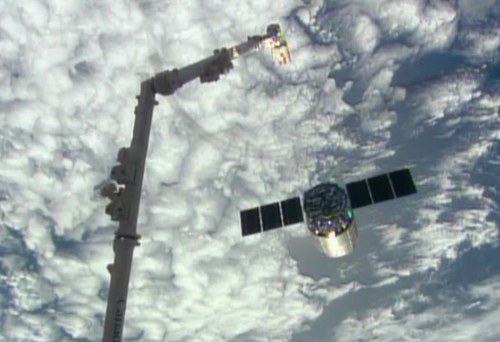 An Orbital Sciences Corporation Cygnus spacecraft departs the ISS on February 18, ending the first of eight such cargo transportation missions for the company. It and SpaceX are likely to compete for a new round of contracts that NASA is beginning the planning for. NASA’s current contracts with Orbital Sciences Corporation and SpaceX for transporting cargo to and from the International Space Station, called Commercial Resupply Services (CRS), cover missions that run through 2016. With the station scheduled to remain in operations to 2020, and now to perhaps at least after the Obama Administration’s announcement of a proposed extension last month, NASA and those cargo providers have to start thinking ahead to a new round of CRS contracts.
On Friday, NASA issued a request for information (RFI) for a “follow on capability” for CRS, or CRS2. The RFI is designed to collect information form industry that would “help NASA refine and mature the follow on acquisition plan” for CRS2. The document doesn’t indicate when NASA would issue a formal RFP for commercial cargo services, but responses to the RFI are due on March 21.
According to the document, CRS2 would cover the period of 2017 through 2024, with funding of $1.0–1.4 billion per year for cargo transportation services. NASA anticipates needing the transportation of 14,250–16,750 kilograms per year of pressurized cargo and 1,500–4,000 kilogram of unpressurized cargo, and the return or disposal of a similar amount of cargo. NASA anticipates four to five missions a year to transport that cargo to and from the station.
Orbital and SpaceX are the two companies that have CRS contracts, with SpaceX preparing to launch its third CRS mission, of twelve, next month and Orbital just completing the first of eight CRS missions earlier this week. At a commercial spaceflight panel Friday night that is part of the SpaceUp Houston “unconference” this weekend, representatives of both companies said they were relatively satisfied with how the current CRS contracts are structured.
“I think the FAR Part 12 commercial contracting we have in place for the CRS program is working very well,” said SpaceX’s Garrett Reisman. That’s a reference to a section of the Federal Acquisition Regulations that cover the acquisition of commercial items. That approach, he said, is much more streamlined than other government contracting mechanisms, and closer to a commercial contract. He added that he hopes that the commercial crew transportation services will follow a similar approach for acquiring crew transportation services once a vehicle or vehicles enter service.
Jeff Siders of Orbital agreed. “The contracting mechanism has worked fine, and we’d see that continuing with no problems,” he said.
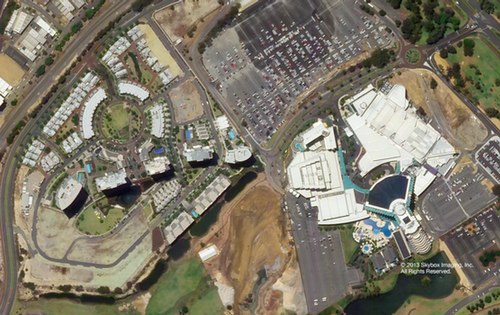 An image of the Crown Perth entertainment complex in Perth, Australia, taken by the SkySat-1 spacecraft in December, among the first images released by Skybox Imaging’s first satellite. That satellite will be joined by a fleet thanks to contracts with two major aerospace companies announced this month. (credit: Skybox Imaging) Skybox Imaging, the commercial remote sensing company that plans to deploy a constellation of small satellites to provide high resolution images and high definition video of the Earth, is ramping up its plans to deploy that fleet of satellites. The company’s first satellite, SkySat-1, was built in-house and launched with about thirty other satellites on a Dnepr rocket last November from Russia. Now, the company is bringing in some well-known space companies to help build and launch those satellites, a departure not just for Skybox but also its partners.
Last week, Skybox and Space Systems/Loral (SS/L) announced a contract where SS/L will build 13 Skybox satellites for launch in 2015 and 2016. “By partnering with SSL, we can leverage their unique production capabilities to scale with greater cost-efficiency and speed while allowing us to focus on prototyping next generation systems to better serve our customers,” explained Skybox vice president Michael Trela in a release.
The arrangement is convenience for Skybox, not just because it frees them up from having o develop a satellite production line: SSL’s satellite manufacturing facility is in alo Alto, California, just up the 101 freeway from Skybox’s office’s in nearby Mountain View. For SSL, though, this is a expansion into a different class of satellite. The company—acquired in 2012 by Canadian company MDA—is best known for building large commercial communications satellites, weighing 6,000 kilograms or more. Each SkySat that SSL builds will weigh in at just 120 kilograms, with dimensions of 60 x 60 x 95 centimeters. “Based on SSL’s unique strengths as a satellite manufacturer and MDA’s heritage, we are developing new capabilities that will enable us to pursue other earth observation and LEO satellite opportunities in the U.S. and abroad,” SSL president John Celli said in a statement.
Yesterday, Skybox and Orbital Sciences Corporation announced a contract to launch at least some of those satellites. The contract covers the launch of six of those satellites on a Minotaur-C rocket from Vandenberg Air Force Base in California in late 2015. The contract, Orbital CEO David Thompson said in a statement, includes “options for additional launch services to support the development of Skybox’s business” beyond the one launch covered by the contract.
The Minotaur-C is a commercial version of Orbital’s existing Minotaur I rocket, placing the Minuteman ICBM motors used in the lower stages of the Minotaur with commercially-procured motors from ATK. (National space policy limits rockets that use retired ICBM motors to launching government-sponsored payloads, so as not to compete with commercially-developed vehicles.) Orbital has talked for some time about developing a commercial variant of the Minotaur to augment or even replace its existing Pegasus and Taurus rockets, and Thursday’s contract is the first announced award for the Minotaur-C.
When Mars One announced in December its plans for its first robotic precursor missions to Mars, it also started a crowdfunding campaign to raise $400,000. Those funds, the Dutch-based nonprofit organization said, would not be used to fund the robotic mission concept studies announced in December for a lander and orbiter, but “will help us achieve our goals more rapidly” and also demonstrate public interest in Mars One’s ultimate plans to send humans on one-way journeys to Mars, officials said then.
The results for Mars One, as the crowdfunding campaign ended earlier this week, are mixed. Mars One fell short of its $400,000 goal, ending up with $313,749, even after extending the deadline for the effort. However, since Mars One used Indiegogo, rather than Kickstarter and its all-or-nothing model, Mars One does get the money it did raise, making it one of the largest space-related crowdfunding efforts to date. Whether it demonstrated the broad public interest in Mars One that the organization hoped, though, remains to be seen.
UK-based Bristol Spaceplanes is also getting into crowdfunding, or, more accurately, crowdinvesting. The company, which has been working on RLV concepts for more than two decades, started an effort to raise £150,000 via the site Crowdcube, offering not gifts but instead a 5% stake in the company itself. So far, nine investors have pledged just £1,660, including one £1,000 investor. The company notes that investors who put £20,000 or more into the company get a free flight that the company expects to cost £100,000 when—or if—the company starts flights. Crowdfunded investment is something not yet allowed in the US, pending the finalization by the Securities and Exchange Commission (SEC) of long-delayed rules for such investment. The SEC did release proposed rules for crowdfunded investment in October for a 90-day public comment period.
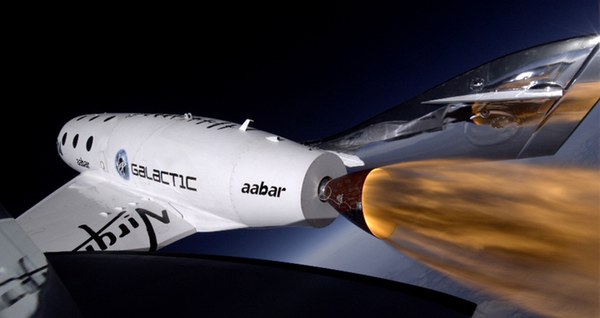 SpaceShipTwo fires its hybrid rocket engine during its third powered test flight on January 10, 2014. (credit: Virgin Galactic) All has been quiet on the SpaceShipTwo test flight front in recent weeks, after the vehicle’s third powered test flight a month ago and a glide test a week later. Despite the lack of public test activity—and continued speculation of problems with the vehicle’s development, including in a recent book—Sir Richard Branson remains confident that SpaceShipTwo will enter commercial service later this year, perhaps after just a few more test flights.
Branson, speaking at the 2014 United Arab Emirates Government Summit Monday in Dubai, said he was still confident that SpaceShipTwo would stary carrying customers on suborbital space tourism flights before the end of the year. “We have 300 engineers beavering away on it,” Branson said, according to Arabian Business. “We have two more test flights [and we should] go into space in three to four months time.”
Last May, Branson, also speaking in Dubai, said he expected to fly in space by Christmas 2013, a date that long since has come and gone. Yesterday, he said he would be worried if he doesn’t fly by the end of this year: “If myself and my family are not in space by the end of the year, I would be very, very worried.”
Branson, at a later event in Dubai, addressed criticism of Virgin Galactic in Tom Bower’s new book. “There are some people who seem to want things to fail and I think he falls into that category,” he said, Bloomberg News reported. “The best way of dealing with people like that is to prove them wrong and we will prove them wrong in the next few months.”
Branson also said Virgin was still planning to develop a spaceport in the UAE. “I hope we’ll have a space hub in Abu Dhabi in a couple of years,” he told the UAE publication The National. In April 2012, Virgin Galactic hired Steve Landeene, the former head of Spaceport America in New Mexico, as its “Chief Advisor, Spaceport Abu Dhabi”.
Virgin Galactic commercial director Stephen Attenborough, though, said that it would be some time before a formal announcement about the spaceport would be ready, and likely not until SpaceShipTwo begins commercial flights from Spaceport America. “Once that is established, we may seek the necessary US export approvals to operate from locations outside the US with Abu Dhabi as a likely first overseas base, should those approvals be forthcoming,” he told The National
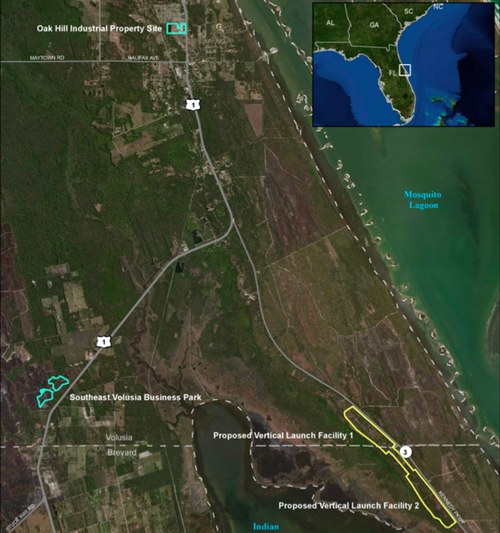 Map of the proposed Shiloh Launch Complex, featuring two pads (lower right), a business park (lower left) and an industrial site (top center). (credit: FAA) This is a big week for those who both support and oppose plans to develop a commercial launch complex north of the Kennedy Space Center in Florida. On Tuesday and Wednesday evening, the FAA’s Office of Commercial Space Transportation will hold “scoping” meetings for a planned Environmental Impact Study (EIS) for what’s known as the Shiloh Launch Complex, named after a former community at the site. The proposed commercial launch site would feature two pads on the Atlantic coast straddling the boundary between Brevard and Volusia counties, a short distance north of KSC, as well as a business park and industrial site. Each pad would be designed to accommodate 12 launches and an equal number of static fire tests per year.
The public hearings—in the city of New Smyrna Beach on Tuesday and Titusville on Wednesday—are intended to solicit input from the community about what should be included in the EIS. That study will get underway later this year and will likely be the critical factor in the request by Space Florida, the state space development organization, for a spaceport license for the facility; without the license, or even with a license that contains sharp restrictions on operations based on the outcome of the EIS, the Shiloh facility may not be built at all.
The proposed Shiloh Launch Complex has aroused interest, and concerns, from the local community. Space Florida and space industry backers see the site as critical to attracting commercial launch activity without the restrictions and overhad of operating at KSC or the Cape Canaveral Air Force Station; supporters plan to attend the hearings wearing red. Critics, though, worry about the facility’s potential negative impact on local wildlife, access to public beaches and wildlife preserves, and even the ruins of a 18th century British sugar plantation. Those concerns are described in detail in an article in Sunday’s Daytona Beach News-Journal.
The official documents about the Shiloh launch site don’t mention a specific customer; instead, the launch pads and associated facilities are designed for “liquid fueled, medium- to heavy-lift class orbital and suborbital launch vehicles.” However, it’s widely believed that the anchor customer for this facility—if it’s built—would be SpaceX, given that company’s long-standing desire for a commercial launch facility separate from the pads it leases at Cape Canaveral and California’s Vandenberg Air Force Base.
Florida, though, isn’t the only state pursuing SpaceX, and the Sunshine State’s bid could be clouded out by Texas. SpaceX has been quietly buying land at a site on the coast of the Gulf of Mexico east of Brownsville, just a few kilometers north of the Mexican border. SpaceX CEO Elon Musk has said on a number of occasions, including a talk last March, that Brownsville was the leading candidate for SpaceX’s planned new commercial spaceport.
That decision could be coming soon, which may be bad news for Shiloh’s supporters. The Brownsville Herald reported last month that the EIS for the Texas site should be completed and released to the public by “late winter.” Since the EIS has traditionally been the “long pole” in any spaceport licensing decision, the release may mean a license could soon follow, long before Shiloh’s EIS is complete. If SpaceX wants to make a decision in the near term about a spaceport site, that would favor Brownsville, provided other factors, including economic incentives provided by state and local governments, come together.
The head of the Commercial Spaceflight Federation (CSF), former astronaut Michael Lopez-Alegria, told the Houston Chronicle recently that he believes SpaceX will select the Brownsville site. “I think all indications are that he will” select Brownsville, Lopez-Alegria said, referring to Musk. “I know that there’s still some talk about Florida, and Space Florida is a member of CSF so I wish them well as well, but it will be interesting to see.”
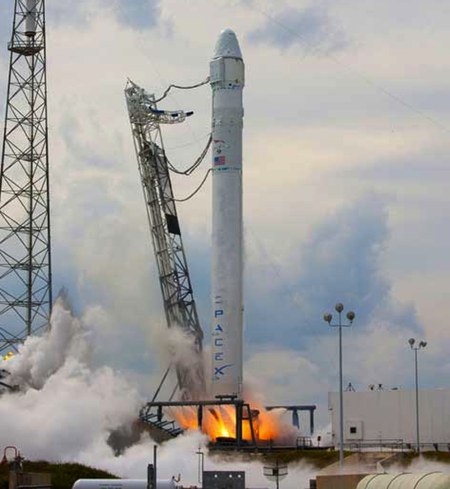 The Falcon 9 carrying the Dragon spacecraft for the CRS-2 (aka SpX-2) mission during an engine test last year. The next SpaceX cargo mission to the ISS, CRS-3/SpX-3, is now scheduled for launch March 17. (credit: SpaceX) The long-awaited third SpaceX Commercial Resupply Services (CRS) cargo mission to the International Space Station (ISS) finally has a firm launch date. The Falcon 9 launch of the Dragon cargo spacecraft on a mission designed CRS-3 by SpaceX (and SpX-3 by NASA) is now scheduled for 4:41 am EDT (0841 GMT) Sunday, March 16 from Cape Canaveral, according to a NASA media advisory published Friday. The mission had previously been scheduled for February 22, but was delayed for unspecified reasons; the new launch date was selected based on “SpaceX readiness, splashdown dates and station activities,” a NASA spokesman told Space News. The mission’s date had been slipping for some time, largely due to launches ahead of the SpX-3 mission and SpaceX work on getting the v1.1 version of the Falcon 9 flying.
The revised date means it will be a little more than a year since the previous SpaceX CRS mission, CRS-2/SpX-2, which launched on March 1, 2013. Since then, Orbital Sciences Corporation has successfully flown its Cygnus spacecraft to the ISS on a Commercial Orbital Transportation Services (COTS) demonstration mission last September, and its first CRS mission, Orb-1, last month.
The Orb-1 Cygnus is still berthed to the ISS. Bill Claybaugh, senior director of human space systems at Orbital, said at the FAA Commercial Space Transportation Conference in Washington on Wednesday that this Cygnus is scheduled to be unberthed from the ISS on February 18, and will reenter one day later. The second Orbital CRS mission, Orb-2, is scheduled for launch May 1, carrying an estimated 1,633 kilograms of cargo to the ISS, Claybaugh said. That will be followed by Orb-3 in October and Orb-4 in January 2015.
Orbital’s current CRS contract is for eight Cygnus missions, currently scheduled into 2016. With ISS current slated to operate to at least 2020, and with the Obama Administration’s announcement of its desire to extend ISS operations to at least 2024, Claybaugh said Orbital is preparing for potential additional CRS missions. “We are already buying long-lead hardware required for those additional missions, and that’s being done at our risk,” he said, since NASA hasn’t announced plans for extending, or recompeting, the current CRS contracts.
It’s not uncommon for the media to mangle space-related developments, either by getting the facts wrong or misinterpreting their importance, as they did recently reporting that Virgin Galactic did not yet have a license for its flights, even though it didn’t need a license now for its test flights and wasn’t even “late” in getting a response from the FAA regarding its application. And, sometimes, even when the media gets the news right, it’s not even new or, even worse, it misses a more significant issue.
That was the case this week with reports that Virgin Galactic is not allowing Chinese nationals to fly. That news, completing with the release of a British book that provided an unflattering assessment of Virgin Galactic, claimed that Chinese citizens were told they needed to get another nation’s passport, or a US green card, in order to fly on SpaceShipTwo. The story appears to trace back to an article in the Daily Mail on January 25, which cited an unnamed Virgin Galactic salesman in Hong Kong (Virgin Galactic does have an “accredited sales agent” there, Miramar Travel Ltd, according to its website.) Other publications picked up on that report, including high-profile ones like The Independent, the South China Morning Post, and CNN.com.
The “good” news about this report is that it is true. NBCNews.com, one of the few outlets who did some original reporting, contacted Virgin Galactic and got a statement from the company confirming the ban on Chinese nationals. “Virgin Galactic adheres to both the spirit and the letter of U.S. export controls and has for now chosen not to accept deposits from countries subject to U.S. export and other regulatory restrictions,” spokesperson Christine Choi told NBCNews.com.
That’s a reference to the fact that space systems like SpaceShipTwo are currently under the jurisdiction of the International Traffic in Arms Regulations (ITAR), a law that places restrictions on the export of sensitive technologies. In particular, ITAR prohibits the export of any technologies that are under its control to selected nations, sometimes called “part 126.1 nations” from the section of ITAR that lists them. Those countries listed in part 126.1 of ITAR include China, which means that such technology can’t be exported to them.
While there are no plans to fly SpaceShipTwo from China, the technical information that companies have to provide passengers both for their safety and to comply with the “informed consent” provisions of their FAA licenses could fall under ITAR. (A reader has since noted that existing law does not explicitly require companies to provide detailed technical information that could run afoul of ITAR in order to obtain informed consent.) Several years ago, Virgin Galactic sought a ruling, called a commodity jurisdiction (CJ), from the State Department about whether such information fell under ITAR or instead under the less restrictive regulations governed by the Commerce Department. In early 2012, the State Department ruled that “Virgin Galactic Commercial Suborbital Space Tourism Experience and Related Required Safety-related Training and Briefings” fell under the jurisdiction of Commerce.
That would seem to get Virgin off the hook of having to comply with ITAR, and its restrictions on various nations, for the purposes of training and preparing customers for spaceflight. In 2009, Bigelow Aerospace sought and received a similar CJ regarding training for people who would fly on its orbital habitats. The report at the time, though, indicated that despite the favorable ruling, people from part 126.1 nations, including China, would still not be able to fly.
The news, though, missed a few things. One is that, despite the flurry of reports in the last week, Virgin’s prohibition on Chinese customers is not new. Back in 2011, for example, CNET reported that “Virgin is not allowed to sell any tickets to China due to US regulatory reasons” as part of a general article about the company. So what seems like a revelation is, in fact, old news.
The second is that the regulatory environment may be changing. The Virgin Galactic spokesperson told NBCNews.com that “Virgin Galactic may adapt its policies in consultation with appropriate regulators, legislators and other stakeholders.” The US government is in the midst of a review of Category XV of the US Munitions List, which covers satellites and related items, with plans for a final version of the revised list due out this spring. However, a draft of that revised Category XV list would keep suborbital crewed vehicles under the control of ITAR, much to the consternation of people in the industry. Moreover, even if suborbital vehicles are moved off the US Munitions List, exports to China (and, thus, presumably, sales of tickets to Chinese customers) would remain prohibited under the terms of the bill that allowed satellites and related items to be taken off the US Munitions List in the first place.
The final, and perhaps most interesting, item missed by the news reports this week is what another suborbital provider is doing. Just over a month ago, Space Expedition Corporation (SXC), the Dutch company that is selling seats on XCOR Aerospace’s Lynx suborbital spaceplane, announced it has named a sales agent in… wait for it… China. “I am extremely excited about this opportunity with SXC as we introduce this unique travel experience to the rest of China,” Alex Zhang, CEO of Dexo Travel, the sales agent for SXC in China, said in the statement. Alex Tang, the head of SXC’s Asia division, added in the statement that the company had seen “a surge in curiosity and interest, esp. from the Chinese market” in recent months. Clearly, SXC is selling seats on Lynx flights to people in China.
SXC, while not an American company, would still appear to be restricted by the same export control regulations as Virgin Galactic, since the Lynx vehicle is American (and currently being built just down the flight line at Mojave Air and Space Port from Virgin Galactic’s facilities.) XCOR does have a CJ from the State Department regarding its Lynx vehicle, issued in late 2011, but the text of that CJ is not publicly available and thus what language it has, if any, about training is not known.
Update: A reader pointed out language in the proposed revised Category XV rule, released last May, that would get Virgin and suborbital companies off the hook entirely with regards to export control issues for training passengers. The fourth page of that document (numbered 31434) states that earlier studies of export control reform had considered the need to include “technology required for passenger participation in space travel” of any type. “The Departments of Defense and State have since reviewed such technology and concluded that it is not per se now subject to USML Category XV,” the document states. “There is thus no proposed inclusion of such technology as a general matter in either the proposed USML Category XV or the proposed 9E515,” a reference to the updated Commerce export control rule. If that provision survives through the final rule, expected to be published this spring, commercial space companies in general would not have to worry about barring Chinese citizens from flying on their vehicles.
The quest by Midland, Texas, to become a hub of commercial space activity notched another victory recently. The Midland Development Corporation (MDC), the city’s economic development organization, announced that commercial spacesuit developer Orbital Outfitters will move to Midland in 2015. The deal covers the construction of a new building on about 2 acres (0.8 hectares) of land at Midland International Airport equipped with an altitude chamber to support spacesuit development and training. The MDC announcement does not give any costs to MDC for the deal, but a report in the Midland Reporter-Telegram says the package offered to Orbiter Outfitters is valued at $6.9 million, including $5.4 million for the headquarters building and altitude chamber complex. The rest covers relocation costs for the company, which currently has offices in Los Angeles and Washington, DC.
Orbital Outfitters becomes the second NewSpace company to announce plans to relocate to Midland. In mid-2012, XCOR Aerospace announced it would move from Mojave, California, to Midland thanks to a $10-million incentive package. “Midland is becoming a destination for aerospace companies looking for the ideal location and collaboration opportunities for their endeavors,” MDC chairman Robert Rendall said in a statement.
Across the state from Midland, Houston-based Waypoint 2 Space announced this week that it has received a safety approval from the FAA from its commercial space training program. An FAA safety approval, according to the agency, is a determination that the approved item or process “will not jeopardize public health and safety, or safety of property, when used or employed within a defined envelope, parameter, or situation.” It is not explicitly required, but makes it easier for launch operators to use approved items or processes as part of their their own vehicles and programs.
Waypoint 2 Space plans to start offering training in “late spring” of this year, with three levels of training planned: a week-long fundamentals course, suborbital training, and orbital training. While the company has its FAA safety approval, the company is still working out agreements with NASA to use facilities at the Johnson Space Center. Ultimately, the company plans to construct its own facilities to provide training.
On Thursday, Sierra Nevada Corporation announced that its Dream Chaser vehicle has started the critical design review (CDR) process, the final major review before beginning actual vehicle construction. However, the milestone the company achieved on its Commercial Crew Integrated Capability (CCiCap) agreement with NASA is what’s called an “incremental” CDR, not the full-fledged final CDR. The milestone was added as an amendment to the company’s CCiCap agreement, pulling out part of an optional milestone in the original agreement. (That original optional milestone, which covered a full CDR, was redacted in the publicly released version of the original CCiCap award.) The incremental CDR is described in the amended CCiCap agreement as “the first of a series of reviews that support the Dream Chaser Space System (Dream Chaser Spacecraft, Launch Vehicle, Mission and Ground Systems) ICDR [integrated CDR].”
|
|








Recent Comments